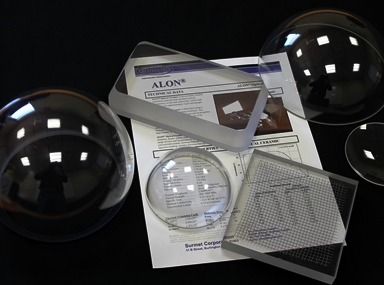The violinist performs in front of a mesmerized audience. Her gown flows as she bows her instrument, notes reaching every ear. But she isn’t in a concert hall. She’s floating in zero gravity aboard SpaceX’s Starship, Elon Musk’s vision of a reusable transportation system that, according to Space X’s information, “will carry crew and cargo into Earth orbit, the Moon, Mars and beyond.”
Behind the violinist is something that enthralls the audience as much as the music – the curve of the earth and stars beyond seen through a 20-foot window.
The imagery described above exists as concept art at Space X – an idealized image of what Starship could be like. All the designs and concept art for Starship to date have included windows. And with good reason. In the new space race windows are big. Panoramas of space inspire their passengers literally, like nothing on earth. But size brings challenges.
Speculation about Starship’s windows is focusing on aluminum oxynitride (AlON – pronounced “aye-lon”), a transparent, metallic ceramic composed of aluminum (Al), oxygen (O) and nitrogen (N). SpaceX founder Elon Musk added to this March 11, Tweeting, “…ALON might be cool” in response to discussion about the window.

The Starship violinist. Concept art from SpaceX
For science fiction and pop culture fans, the name – or the idea of “transparent aluminum” brings up a memory or two. In 1986’s Star Trek IV: The Voyage Home, Scotty knew what he needed to transport two humpback whales and water enough to float them to the 23rd century – walls made of transparent aluminum. In the film’s story, he gave the “recipe” for transparent aluminum to an engineer in 1986, in exchange for enough of the material to make a whale-sized tank on the Klingon Bird of Prey he and the crew were traveling on.
A couple of things to be clear on: first, the screenwriters for the film were probably tipped off on the idea of “transparent aluminum” by checking out some (then) cutting edge materials science. AlON had been around for a little while by the point the film was being written and was starting to make waves, given its properties. Second – “transparent aluminum” is not AlON. AlON is a ceramic made with aluminum that happens to be transparent. It is possible to make elemental aluminum transparent with pulses of soft X-ray light…but that’s not what’s being talked about for Starship. “Transparent aluminum” and AlON are often, and mistakenly, used interchangeably in news stories, but they’re not the same thing.
AlON also made a cameo appearance in 2015’s Jurassic World as well. The gyrospheres designed for park visitors to roll their way into the park and travel safely among the dinosaurs were made out of AlON, which explained their durability as well as their crystal-clear transparency.
But we’re talking about our world, our reality now.
How realistic is a wall of AlON that can survive the stresses of spaceflight as well as potential hypervelocity impacts with micrometeorites and space junk, while remaining crystal clear? I spoke with experts to find out.
Invented in the mid 1970s by Jim McCauley, AlON is a material that seems destined for space. “It’s very hard and has a very high compressive strength, and is optically transparent – it lets in visible light, some infrared and a little ultraviolet,” McCauley said. “There are some other materials out there that are similar, but AlON just performs better. It’s what I’d want on my spaceship.”
Comparing AlON to glass laminate most often used for spacecraft windows strengthens McCauley’s case. The material is an 8 on the Mohr hardness scale (diamond is 10). 1.6 inches of AlON plate can stop a 50-caliber bullet, which flies effortlessly through 3.7 inches of laminate. Unsurprisingly, AlON is the “it” material of the military when it comes to transparent armor, as well as domes on the front of missiles. The guidance instruments inside the missile can “see” through the AlON dome, while its hardness prevents scratches and cracks as the missile flies.
Testing AlON’s performance in hypervelocity environments is needed as the windows would play an armor role on Starship. Moving at thousands of miles an hour, micrometeorites and debris carry far more energy than bullets. The more of a ship’s surface made of windows, the greater the risk of impact, so windows need to be strong.
“When something hits your window at these velocities, there’s so much energy involved you can have phase transformations – whatever the window is made out of can go right into the plasma state,” said Dr. Leslie Lamberson who studies impact physics at the Colorado School of Mines. “So you could use AlON, given its hardness, but with some layering of other materials to help with impacts.”
Hypervelocity impacts would be the greatest challenge the windows would face, the experts agree, and suggest temporary ballistic window shielding for added protection as needed. It was also agreed that given AlON’s physical properties, windows would be able to withstand the conditions associated with the multiple launches and re-entrys Starship would experience.
While AlON is good for getting to and from space and surviving in-space impacts, moving from an ideal choice to reality is another challenge.
Since McCauley invented it in the ‘70s, one thing has remained the same: AlON is a finicky material to produce.
“One of the issues to be concerned with is purity,” said Dr. K.T. Ramesh, Director of the Hopkins Extreme Materials Institute. “It’s not just about making the pieces big enough, but also finishing the surface correctly.”
There are two approaches to the manufacturing issue. The first: call Surmet.
The Massachusetts-based company has been making AlON for nearly 20 years and has the tools and expertise to make window-sized plates. The company’s AlON output is mostly used in military and industrial applications.

A sampling of Surmet’s ALON offerings, image credit: Surmet
This is an expensive option. Surmet did not respond to requests for information, but a widely-reported price for Surmet’s “ALON” (Surmet’s trade name for its products) is $10 – $15 per square inch, compared to $3 for laminate glass. A window configuration for Starship could reach half a million dollars.
The second solution for sourcing AlON: make your own.
Transparent AlON panels begin as a flour-like white powder that is painstakingly processed to ensure its purity. That pure powder is pressed into molds which are baked in a 2000 oC furnace for days. While it bakes, the AlON grains lock into place, turning it from powder to an optically isotropic, polycrystalline structure. More simply, solid AlON is made of crystals, and the properties of the material are the same in all orientations. This is responsible for much of its strength as well as its transparency.
“There are a lot of steps that go into making AlON,” McCauley said, “But once you get the process down, you can just pump the pieces out.”
McCauley’s comment carries irony.
None of the steps in manufacturing AlON are easy or cheap. Impurities scatter incoming light, affecting transparency. Chemical impurities also lead to weaknesses in the final product, giving rise to cracks or other structural imperfections. Likewise, polishing AlON is an exacting process, performed by tools capable of polishing ultra-hard material. The larger the piece of AlON, the greater the chance of something going wrong.
Ultimately, knowing the chemical formula for AlON and producing window panels for your spaceship is like knowing the ingredients for Doritos and being able to cook up a batch of the chips in your kitchen. In theory, it’s not impossible, but it’s going to be pretty difficult without the right knowledge, the right process and the right tools.
Musk’s Tesla and SpaceX have materials science and glass divisions, and could, in theory, make AlON. As explained by Musk (and evidenced by the infamous Armor Glass demonstration on the Cybertruck), tougher glass is something both Tesla and SpaceX are acutely interested in actively working on.
But it would take time and money to get a manufacturing facility producing usable AlON panels. Also, McCauley said that he expects new players, most likely from Europe and China, to enter the AlON field soon, providing alternative sources for panels. SpaceX did not respond to inquiries regarding Starship’s windows.
Despite potential impacts and sourcing, experts demonstrate the optimism inherent in materials science and engineering : AlON is a good choice for Starship windows and any challenges are manageable.
Both Ramesh and Lamberson suggest a window-wall of many panels, rather than a monolithic curved plate. Joints and connectors between panels are structural weak points, but one curved panel of AlON is beyond the capabilities of Surmet (or any AlON manufacturer), given its size and finishing requirements. Anything with a curve, from a gentle one of a window-wall to the domes like Surmet manufactures is more complicated to produce and polish than a flat plate.

SpaceX concept art – multiple Starships (note the windows at the top) at a base on Mars
Challenges addressed, the focus shifts to the benefits of mass and durability.
In terms of armor, a thinner piece of AlON performs better than a thicker piece of glass. That’s less window mass moving spaceward – a nontrivial cost savings. Each kilogram pushed into space has a dollar amount.
And AlON doesn’t scratch, chip, or crack as often as glass laminate does, reducing the replacement of panels, keeping materials cost down. If impacts can be avoided or minimized, and any small cracks prevented from spreading and growing, AlON’s lifespan could outlast that of Starship itself.
For now, the window behind the violinist exists only in SpaceX concept art, much like Starship itself did, just three years ago. Though there are hurdles to overcome, experts agree – AlON is an ideal choice for Starship’s windows. And based on his comments about AlON, Musk – who’s not one to back down from promises or teases – appears to feel the same. Whether that means SpaceX is testing, buying or making their own, the view from Starship will be fantastic.
Starship and currently undergoing tests at SpaceX. Regular updates on the tests, as well as videos of the flights can be found at the SpaceX site.







